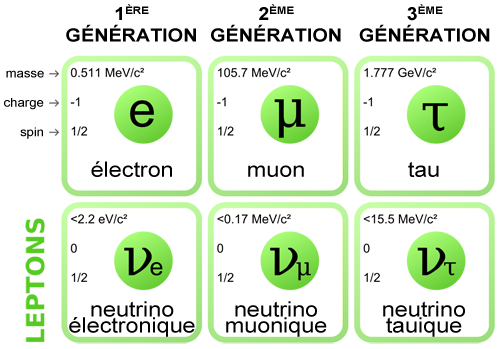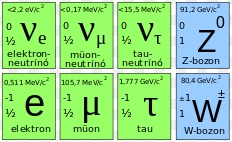
τ + and τ – can be formed by an electron- positron (antielectron) pair combining. When a single tauon decays, it is the only lepton that can decay into hadrons (things made of quarks). Also, τ + and τ – can annihilate each other in a form of decay. Tauons themselves are unstable, and can decay. Since antimatter has the opposite of charge of regular matter, anti-tauons have a charge of +1, and can be written as τ +. Tau have a charge of -1, and can be written as τ –. Like the other two basic leptons, tauons have a neutrino named after them (the tau neutrino). However, they are very important in the decay of subatomic matter. Since they only live for 2.9x10 –13 seconds, they do not have a significant role in the regular world. This is because they have about 3,500 times as much mass as electrons, and about 17 times as much mass as muons. Tau leptons can be thought of as very heavy electrons, as they are both leptons. This means that they are believed to be so small that they can not be divided any more. Exotic atoms with muons and taus instead of electrons can also be synthesized, as well as lepton–antilepton particles such as positronium.Tau (τ) leptons (aka tauons, tau particle) are one of the very small elementary particles. Electrons are one of the components of atoms, alongside protons and neutrons. Leptons are an important part of the Standard Model. The tau neutrino remained elusive until July 2000, when the DONUT collaboration from Fermilab announced its discovery. Lederman, Melvin Schwartz and Jack Steinberger, and the tau discovered between 19 by Martin Lewis Perl and his colleagues from the Stanford Linear Accelerator Center and Lawrence Berkeley National Laboratory. The muon neutrino was discovered in 1962 by Leon M. It was first observed in the Cowan–Reines neutrino experiment conducted by Clyde Cowan and Frederick Reines in 1956. The first neutrino, the electron neutrino, was proposed by Wolfgang Pauli in 1930 to explain certain characteristics of beta decay. It took until 1947 for the concept of "leptons" as a family of particle to be proposed. After investigation, it was realized that the muon did not have the expected properties of a meson, but rather behaved like an electron, only with higher mass. Anderson in 1936, which was classified as a meson at the time. The next lepton to be observed was the muon, discovered by Carl D. The first charged lepton, the electron, was theorized in the mid-19th century by several scientists and was discovered in 1897 by J. However, according to certain theories, neutrinos may be their own antiparticle, but it is not currently known whether this is the case or not. For every lepton flavor there is a corresponding type of antiparticle, known as antilepton, that differs from the lepton only in that some of its properties have equal magnitude but opposite sign. Unlike quarks however, leptons are not subject to the strong interaction, but they are subject to the other three fundamental interactions: gravitation, electromagnetism (excluding neutrinos, which are electrically neutral), and the weak interaction. Leptons have various intrinsic properties, including electric charge, spin, and mass. Thus electrons are stable and the most common charged lepton in the universe, whereas muons and taus can only be produced in high energy collisions (such as those involving cosmic rays and those carried out in particle accelerators). The heavier muons and taus will rapidly change into electrons through a process of particle decay: the transformation from a higher mass state to a lower mass state. Electrons have the least mass of all the charged leptons. The first generation is the electronic leptons, comprising the electron () and electron neutrino () the second is the muonic leptons, comprising the muon () and muon neutrino () and the third is the tauonic leptons, comprising the tau () and the tau neutrino.

There are six types of leptons, known as flavours, forming three generations. Charged leptons can combine with other particles to form various composite particles such as atoms and positronium, while neutrinos rarely interact with anything, and are consequently rarely observed. Two main classes of leptons exist: charged leptons (also known as the electron-like leptons), and neutral leptons (better known as neutrinos).

The best known of all leptons is the electron, which governs nearly all of chemistry as it is found in atoms and is directly tied to all chemical properties. A lepton is an elementary, half-integer spin (spin ) particle that does not undergo strong interactions, but is subject to the Pauli exclusion principle.

See: Point Particle, Positronium, Beta Decay, Electron, Electron Neutrino, Muon, Muon Neutrino, Tau (Particle), Tau Neutrino, Elementary Particle, Fermionic, Electromagnetism, Gravitation.A Lepton Particle is an Elementary Particle that.


 0 kommentar(er)
0 kommentar(er)
